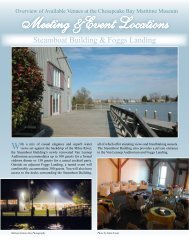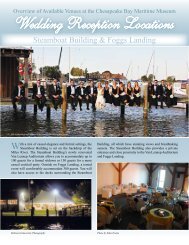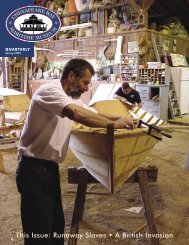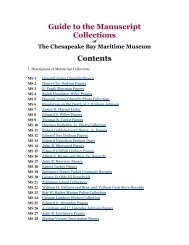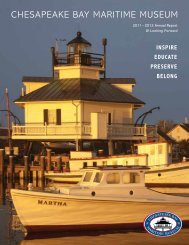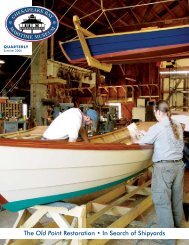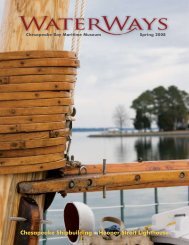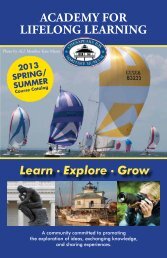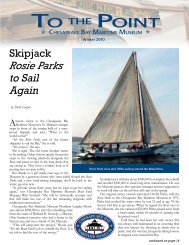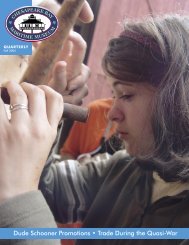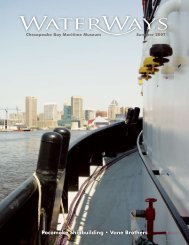Fall 2008 - Chesapeake Bay Maritime Museum
Fall 2008 - Chesapeake Bay Maritime Museum
Fall 2008 - Chesapeake Bay Maritime Museum
You also want an ePaper? Increase the reach of your titles
YUMPU automatically turns print PDFs into web optimized ePapers that Google loves.
8<br />
To the Point<br />
National Fish and Wildlife<br />
Foundation Awards CBMM<br />
$100,000 Grant<br />
The <strong>Chesapeake</strong> <strong>Bay</strong> Program and the National Fish<br />
and Wildlife Foundation (NFWF) recently awarded CBMM<br />
a $100,000 matching grant for construction of 12,670<br />
square feet of living shoreline on the <strong>Museum</strong>’s waterfront.<br />
CBMM’s project was one of 34 environmental projects in<br />
the <strong>Chesapeake</strong> <strong>Bay</strong> watershed awarded funding through the<br />
<strong>Chesapeake</strong> <strong>Bay</strong> Small Watershed Grants program, which<br />
provides grants to organizations and municipal governments<br />
working to improve the condition of their local watershed.<br />
NFWF awarded a total of $2.1 million in grants for projects<br />
that will protect 3,400 acres of land, restore approximately<br />
15 miles of streams and plant more than 160 acres of marsh<br />
and wetland grasses.<br />
Staff from the <strong>Chesapeake</strong> <strong>Bay</strong> Trust use a seine net to sample<br />
the diversity of species before a living shoreline is constructed at<br />
the <strong>Museum</strong>.<br />
“Each project receiving a Small Watershed Grant this<br />
year is a vital component of the broad partnership of organizations<br />
working to restore the <strong>Bay</strong> and its local waterways,”<br />
said Jeffrey Lape, director of the <strong>Chesapeake</strong> <strong>Bay</strong> Program.<br />
CBMM will use the NFWF funds to construct a new<br />
marsh to treat storm water runoff from impervious surfaces<br />
before it reaches tidal waters. The new marsh will enhance<br />
the shoreline and provide for vegetative shoreline erosion<br />
control and marsh edge protection along the <strong>Museum</strong>’s Miles<br />
River shoreline.<br />
The project will be designed to eliminate point source<br />
storm water discharge and construct a low profile stone containment<br />
structure (sill) along 622 linear feet of shoreline in<br />
the Miles River Watershed. In addition, approximately 0.3<br />
acres of new marsh will be constructed and protected.<br />
Sea grass grating bridging a vegetated swale to allow<br />
sunlight to reach the plantings below will replace a portion<br />
of the <strong>Museum</strong>’s existing boardwalk. This living shoreline<br />
will become a new outdoor living classroom that will be<br />
viewed and interpreted to the <strong>Museum</strong>’s 80,000 annual visitors<br />
including more than 11,000 Maryland and Mid-Atlantic<br />
students from public, private and home schools.<br />
“Locally driven conservation projects (like the one proposed<br />
by the <strong>Chesapeake</strong> <strong>Bay</strong> <strong>Maritime</strong> <strong>Museum</strong>) not only engage<br />
communities in restoring their local streams and watersheds,<br />
collectively, they are key to restoring one of the country’s most<br />
vital natural resources – the <strong>Chesapeake</strong> <strong>Bay</strong>,” noted Mike Slattery,<br />
director of NFWF’s Eastern Partnership Office.<br />
CBMM Participating<br />
in National Economic<br />
Impact Study<br />
CBMM is one of 16 museums from the across the country<br />
chosen to participate in a three-year study of the economic<br />
impact of museums on their communities. The North<br />
Adams, Mass.-based Center for Creative Community Development<br />
(C3D) launched the study, “<strong>Museum</strong>s in the Neighborhood,”<br />
in 2006.<br />
“Cultural organizations, even relatively small ones, impact<br />
their neighborhoods and their communities. They have<br />
an economic impact on their community through their annual<br />
budget as it circulates through the local economy. But<br />
they also impact their community by making it a more attractive<br />
place to live, by offering educational programming, and<br />
by being a local gathering place,” notes Stephen Sheppard,<br />
Ph.D., professor of economics at Williams College and director<br />
of the C3D project.<br />
The project will provide CBMM and the other museums<br />
participating in the study with a suite of tools to evaluate their<br />
general impact or the success of programs that target community<br />
members. Funding for the research project has come from<br />
the Ford Foundation through its “Shifting Sands: Art, Culture,<br />
and Neighborhood Change” initiative, with assistance from<br />
Partners for Livable Communities, the Institute for <strong>Museum</strong><br />
and Library Services, and Williams College.<br />
ALL Offers New Courses &<br />
New Interview Series<br />
The Academy for Lifelong<br />
Learning (ALL), which is sponsored<br />
by the <strong>Chesapeake</strong> <strong>Bay</strong> <strong>Maritime</strong><br />
<strong>Museum</strong>, will offer the first<br />
of a new interview series, “Distinguished<br />
Residents of the Eastern<br />
Shore,” and 14 courses for the fall<br />
<strong>2008</strong> semester.<br />
The first program of the new series<br />
will feature an interview with<br />
Senator Birch <strong>Bay</strong>h is the<br />
first in a new interview<br />
series for ALL.<br />
Senator Birch <strong>Bay</strong>h (former U.S.<br />
Senator-Indiana) by Wilson Wyatt,<br />
Jr. It will be held on Monday, No-



